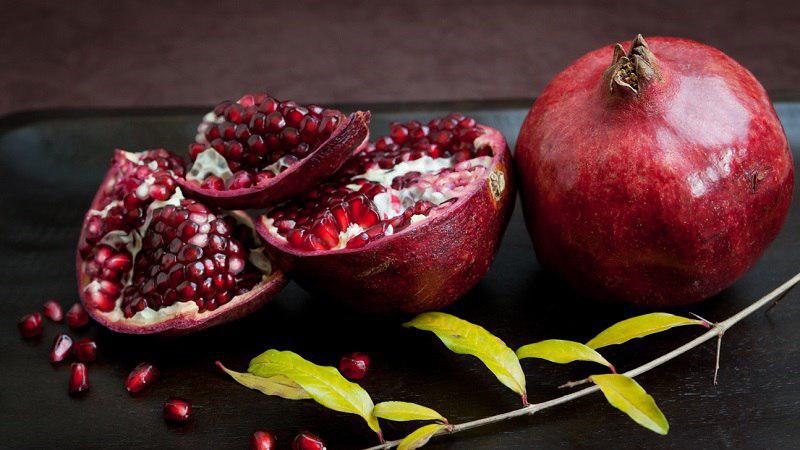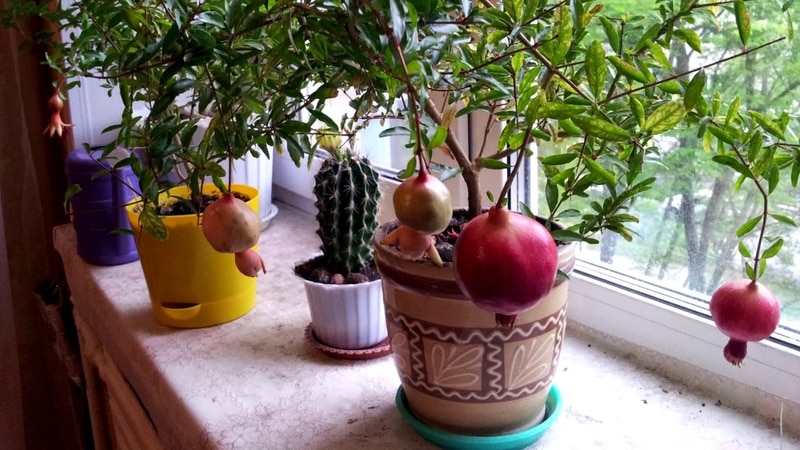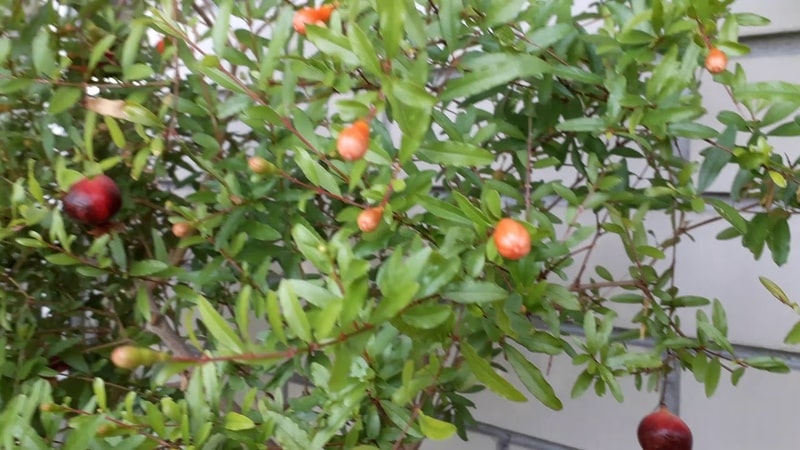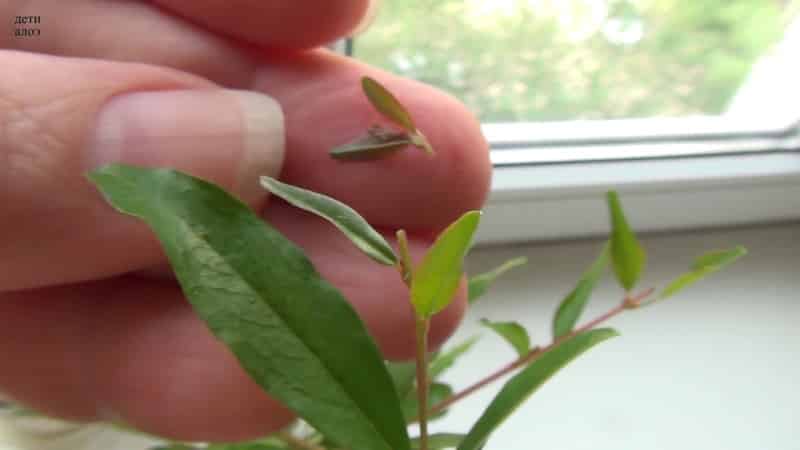Beginner's Guide: How to Care for Potted Pomegranates at Home
The flowering of pomegranate amazes with its splendor: against the background of a bright lime openwork crown, many red-coral flowers bloom, reminiscent of small roses. The pomegranate tree, pomegranate, or simply pomegranate, is common in the subtropics of Western Asia and Southern Europe, and lovers of exotic fruit plants successfully grow it at home.
In order for a plant on the windowsill to feel like it is in its native environment, it needs to be provided with close to natural conditions and proper care. We will tell you further how to care for pomegranates in a pot at home.
Features of growing pomegranate at home

Under natural conditions, the pomegranate tree resembles a phoenix bird. In the desert, everything smells fragrant and blooms only in early spring. In just a few days, scarlet poppies and tulips “burn out” here. And pomegranate slowly unfurls its delicate leaves and begins to bloom by summer, decorating desert landscapes until September.
Such difficult living conditions have developed the plant’s own biorhythms and characteristics:
- Drought resistance and ability to grow in dry air. But this does not mean that you need to test the flower for strength. At room temperature, pomegranate is watered more often than it receives moisture in nature.
- High requirements for lighting levels.
- Deciduousness.
- Durability. Life expectancy with good care reaches 50 years.
- Presence of a period of rest.
- Loves light, well-drained soils.
Another feature of pomegranate is its love of fresh air. In the spring, when the temperature reaches above +16°C, the plant is taken out to an open balcony or loggia and kept there until mid-September (weather conditions permitting).
Reference. A pomegranate has nothing in common with a grenade. Translated from Latin it means “grainy”.

Suitable varieties
Indoor pomegranate is a group of varieties created from the dwarf variety Punica granatum var. nana. Pomegranate trees are often found on sale without specifying the variety, under the same name Dwarf Pomegranate Nana. The peculiarity of the dwarf group of varieties is their small height, in the range of 60-120 cm.
As of 2019, the following varieties of indoor crops have been developed.
Carthage
Bush up to 100 cm high, with small emerald elliptical leaves located opposite each other. The flowers are coral, 2.5-4 cm in diameter, bloom from May to August.
The fruits are up to 7 cm in diameter, sweet and sour. The skin of the fruit is thin, the grains are small.
Baby
The plant is more miniature than the Carthage variety (up to 50 cm). It is a branched, densely leafy shrub. The leaves are light green, up to 3 cm in length, elliptical in shape. The branches have sparse thorns. The flowering period of the variety begins in March and ends in November. The flowers are large, up to 7 cm, coral-red.
The fruits are medium in size, up to 4 cm. To achieve a larger mass of fruits, it is recommended to leave no more than 5 ovaries on the plant.
Attention! In indoor conditions, not only special varieties, but also other varieties of fruit crops grow successfully. Cultivated pomegranate flowers are larger than dwarf ones. But you won’t be able to get fruits weighing 500 g from a cultivated pomegranate.
Optimal conditions of detention
For the dwarf pomegranate to feel good, it is important to comply with the recommended or as close to ideal growing conditions as possible:
- Lighting. In natural growing conditions, the pomegranate tree literally bathes in the rays of the sun. The more light it gets during the day, the better. In autumn and winter, in the morning and evening hours, it is useful to illuminate the bushes with phytolamps. The exception is direct sunlight in March and June-July. At this time, the tree needs light shading using screens made of gauze or light, thin spunbond.
- Location. The brightest window in the house (north window will not work).
- Temperature. During the growth period, the plant is kept at a temperature of +22…+25°C. When the fruits form and grow on the pomegranate, the temperature is maintained at +14…+16°C.
- Humidity. Indoor pomegranate is not afraid of dry air. It grows well at a humidity of 50-60%.

Preparatory stage
Before planting, prepare tools and materials.
Tara
First, select the appropriate container. For purchased adult plants, this is a flat and tight pot (the tighter the container, the fewer sterile bell-shaped flowers will form), for Cherenkov and seeds - a plastic container, box, glass (many summer residents use paper bags and cans of dairy products for these purposes).
Any container is thoroughly washed with dishwashing detergent (or better yet, laundry soap) and disinfected with a strong solution of rich pink potassium permanganate (2-3 g of powder per 100 ml of water).
Priming
The pomegranate tree needs light soil with a neutral acid-base reaction (pH = 6.5-7). Under natural conditions, it grows on poor, dry sandy or rocky soils.But this does not mean that the degree of soil fertility is not important to the plant. On rich turf-humus soils, the shrub blooms more profusely and bears larger fruits.
For indoor pomegranate you need the following soil composition:
- turf;
- humus;
- leaf soil;
- sand.
All components are taken in equal parts. Fine expanded clay is added to the finished soil for better aeration. Dwarf pomegranate is susceptible to whitefly attack. Therefore, before planting, the soil is spilled with boiling water (this is how the larvae are killed) and etched with a solution of the chemical preparation “Aktara”. Prepare a solution in warm water. Dosage: 8 g of the drug per 10 liters of water.
Planting material
Having bought a plant, the flower is allowed to stand in quarantine for 3-5 days. This is necessary to understand whether pests or diseases were introduced with the purchase. And the pomegranate needs time to get used to the conditions of the new room. An hour before transplanting, water the plant abundantly.
How to plant a pomegranate correctly

If a pomegranate is purchased in spring or summer, it is transplanted into a new pot after maintaining quarantine. In autumn and winter, transplantation is undesirable, so it is postponed until the spring of the new year.
Step-by-step transshipment technology:
- Take a clean flat container 20-30 mm larger than the previous pot.
- The drainage hole at the bottom of the pot is covered with a clay shard or large expanded clay.
- A layer of expanded clay is poured onto the bottom, followed by 1 cm of sand.
- Prepared soil is poured on top in the form of a mound.
- The plant is pulled out of the pot, the roots are slightly straightened with a garden cat. Dead roots are removed.
- Soil is poured into the pot on top and lightly compacted on the sides with a wooden peg to prevent the formation of air voids in which the roots do not receive water and nutrition.
- Water the soil generously with water or Zircon solution for better rooting (1 ampoule per 10 liters of water).
After replanting, the plant will slightly stop growing or even shed some leaves. This is how the fruit tree reacts to the transplantation procedure. If the situation does not change within a week, repeat watering with the Zircon solution.
Further care
Plants that have successfully survived the transplant require proper care.
Watering
The signal of a plant's thirst is when the soil in the pot dries out to a depth of 2 cm. The frequency of watering depends on the climate of the room (humidity, light level, temperature).
Under conditions close to the required ones, the plant needs water:
- in summer - daily or every other day;
- in September the quantity is gradually reduced;
- from November to March water once a week.
In spring, the soil under the pomegranate is moistened after 1-2 days. In addition to water at the root, daily spraying is useful in the spring and summer, especially if the air temperature is above +25°C.

Feeding
With a properly structured feeding scheme, the plant not only blooms profusely, but also bears fruit. Fertilizer application schemes:
- mid-March - watering with ash solution (1 teaspoon of sifted ash per 10 liters of water);
- beginning of April - watering with mullein solution (1 tbsp per 1 liter of water);
- every 2 weeks until September, the flower is fed with any liquid complex fertilizer for indoor fruit;
- at the beginning of September, the pomegranate is fertilized for the last time with phosphorus-potassium fertilizer (1 tablespoon per 10 liters of water).
In winter, the plant does not need fertilizing.
Trimming and shaping
The branches of the pomegranate grow randomly, there are a lot of them. The main rule is to spare no expense and cut off small branches as much as possible. This is done in January, before the leaves bloom.Then the pomegranate is pruned as it overgrows according to the same principle - removing small weak branches. A properly formed plant has 4-6 skeletal branches from the root.
If the pomegranate is formed in the form of a tree on a trunk, 1 main stem is left, which is pinched at a height of 15-20 cm and skeletal branches are formed. In standard trees, in addition to formative pruning, growing shoots are removed.

Protection from diseases and pests
Indoor pomegranate pests are introduced with planting material or purchased soil.
These are greenhouse insects:
- whitefly;
- scale insect;
- spider mite
These pests can be easily destroyed by a single treatment with a complex pesticide of hazard class 3, for example, Aktara or Fitoverm. After treatment, the plant is isolated from other flowers and its condition is monitored.
Diseases are caused mainly by violations of agricultural technology:
- yellowing of leaves - due to high air temperatures, drying out of the soil in the pot, lack of iron, molybdenum.
- leaf fall can be natural, before winter sleep, or due to dry soil;
- drying of leaves or individual branches is associated with problems of the root system caused by overdrying or waterlogging of the soil (mold, root rot, cancer).
Before treating diseases, it is important to accurately determine their cause. To do this, inspect the flower, and if the soil does not dry out well, reduce watering. Spray with Epin solution or water with Zircon if the plant is not flooded.
If there is no improvement, the flower is pulled out of the pot and the roots are examined. If rot is detected, they are cut back to healthy ones, sprinkled with Kornevin powder and transplanted into a new pot.
Rest period
From November to March the tree sleeps. At this time, lower the temperature to +16...+18°C and reduce watering.Cool conditions in the absence of a basement or balcony are created by moving the flower close to the window and separating it with film from the rest of the room.
Important! Without winter hibernation, pomegranate lags behind in growth, becomes more vulnerable to diseases, and degenerates according to varietal characteristics. Try to provide rest for the tree for at least 2 weeks (the minimum dormant period for a crop).
How to propagate indoor pomegranate
Pomegranate is propagated by seeds and cuttings.
Cuttings
Reproduction begins in the spring, in late February - early March. For planting, one-year-old cuttings 20-25 cm long are selected. At the bottom they are cut under the bud, at the top - between the buds. The bottom is treated with Kornevin.
Rooting is done in two ways:
- in water: the cuttings are placed in a container with water for 2-3 weeks;
- in the ground: buy universal soil, perlite, vermiculite, keep it for 2-4 weeks, covered with film, periodically ventilate and moisten the soil.
Pomegranates are replanted using the transshipment method.
Seeds
Only seeds in a soft shell are planted, and not dry seeds. The grains are kept for 6-8 hours in a growth stimulator or aloe juice. Sow in clean peat or a mixture of peat with coarse sand or perlite. The container is covered with film, which is removed after germination. Plants are placed in a well-lit place. When the seedlings grow to 4-5 cm, they are planted.
How to replant
Further transplants are required for the plant every year upon reaching 5 years of age. Large tub specimens are transferred once every 3-5 years. The transplantation technology is similar to the initial planting of the plant.
This is interesting:
How to grow peppers in pots: photos, growing technology and useful tips.
Plant compatibility: what to plant basil next to and why it is important.
Conclusion
Of all the subtropical fruit indoor plants, pomegranate is the most promising crop for beginners. Unlike citrus fruits or feijoa, it does not have strict requirements for the duration of the dormant period and low temperature limits in combination with high humidity.
The tree should be formed and fed in time, then it will respond to care with luxurious flowering. The ripening of mini-pomegranates is interesting for children, so caring for the fruit crop can be turned into a family hobby.